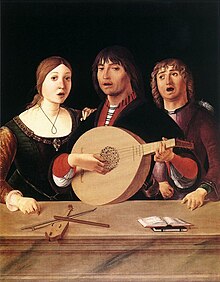
John Dowland was an English Renaissance composer, lutenist, and singer. He is best known today for his melancholy songs such as "Come, heavy sleep", "Come again", "Flow my tears", "I saw my Lady weepe", "Now o now I needs must part" and "In darkness let me dwell". His instrumental music has undergone a major revival, and with the 20th century's early music revival, has been a continuing source of repertoire for lutenists and classical guitarists.
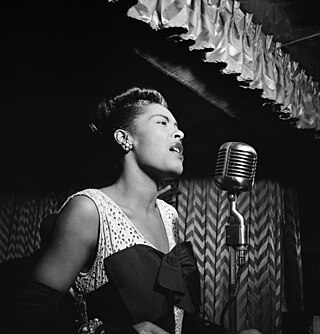
A song is a musical composition performed by the human voice. This is often done at distinct and fixed pitches (melodies) using patterns of sound and silence. Songs contain various forms, such as those including the repetition and variation of sections.

Thomas Campion was an English composer, poet, and physician. He was born in London, educated at Cambridge, studied law in Gray's inn. He wrote over a hundred lute songs, masques for dancing, and an authoritative technical treatise on music.
An air is a song-like vocal or instrumental composition. The term can also be applied to the interchangeable melodies of folk songs and ballads. It is a variant of the musical song form often referred to as aria.

A madrigal is a form of secular vocal music most typical of the Renaissance and early Baroque (1600–1750) periods, although revisited by some later European composers. The polyphonic madrigal is unaccompanied, and the number of voices varies from two to eight, but usually features three to six voices, whilst the metre of the madrigal varies between two or three tercets, followed by one or two couplets. Unlike the verse-repeating strophic forms sung to the same music, most madrigals are through-composed, featuring different music for each stanza of lyrics, whereby the composer expresses the emotions contained in each line and in single words of the poem being sung.
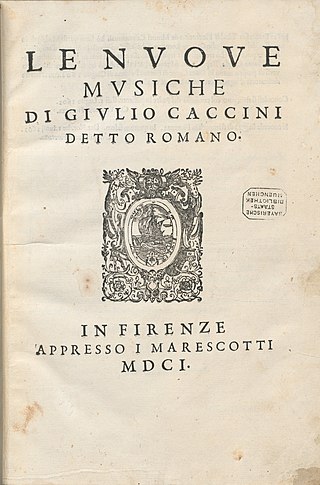
In music, monody refers to a solo vocal style distinguished by having a single melodic line and instrumental accompaniment. Although such music is found in various cultures throughout history, the term is specifically applied to Italian song of the early 17th century, particularly the period from about 1600 to 1640. The term is used both for the style and for individual songs. The term itself is a recent invention of scholars. No composer of the 17th century ever called a piece a monody. Compositions in monodic form might be called madrigals, motets, or even concertos.

The frottola was the predominant type of Italian popular secular song of the late fifteenth and early sixteenth century. It was the most important and widespread predecessor to the madrigal. The peak of activity in composition of frottole was the period from 1470 to 1530, after which time the form was replaced by the madrigal.
The air de cour was a popular type of secular vocal music in France in the late Renaissance and early Baroque period, from about 1570 until around 1650. From approximately 1610 to 1635, during the reign of Louis XIII, this was the predominant form of secular vocal composition in France, especially in the royal court.
France has a rich music history that was already prominent in Europe as far back as the 10th century. French music originated as a unified style in medieval times, focusing around the Notre-Dame school of composers. This group developed the motet, a specific musical composition. Notable in the high Middle Ages were the troubadours and trouvères soon began touring France, composing and performing many original songs. The styles of ars nova and ars subtilior sprung up in the 14th century, both of which focused on secular songs. As Europe moved into the Renaissance age, the music of France evolved in sophistication. The popularity of French music in the rest of Europe declined slightly, yet the popular chanson and the old motet were further developed during this time. The epicenter of French music moved from Paris to Burgundy, as it followed the Burgundian School of composers. During the Baroque period, music was simplified and restricted due to Calvinist influence. The air de cour then became the primary style of French music, as it was secular and preferred by the royal court.

During the reign of Queen Elizabeth I (1558–1603), English art and high culture reached a pinnacle known as the height of the English Renaissance. Elizabethan music experienced a shift in popularity from sacred to secular music and the rise of instrumental music. Professional musicians were employed by the Church of England, the nobility, and the rising middle-class.
Étienne Moulinié was a French Baroque composer. He was born in Languedoc, and when he was a child he sang at the Narbonne Cathedral. Through the influence of his brother Antoine, Moulinié gained an appointment at court, as the director of music for Gaston d'Orléans, the younger brother of the king. For this post he wrote sacred and secular music, for voice or voices and lute or continuo. He also wrote music to accompany the ballet or other dances. He taught Gaston's daughter, Mlle de Montpensier. Moulinié worked for Gaston until the latter's death in 1660, at which point he was forced to find new employment. For this he returned to his birthplace of Languedoc.
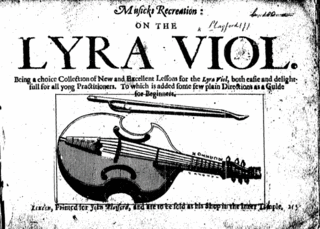
The lyra viol is a small bass viol, used primarily in England in the seventeenth century.
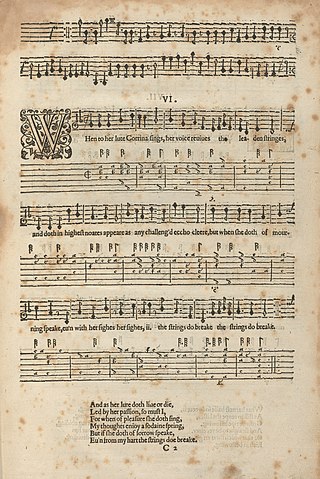
Philip Rosseter was an English composer and musician, as well as a theatrical manager. His family seems to have been from Somerset or Lincolnshire, he may have been employed with the Countess of Sussex by 1596, and he was living in London by 1598. In 1604 Rosseter was appointed a court lutenist for James I of England, a position he held until his death in 1623. Rosseter is best known for A Book of Ayres which was written with Thomas Campion and published in 1601. Some literary critics have held that Campion wrote the poems for Rosseter's songs; however, this seems not to be the case. It is likely that Campion was the author of the book's preface, which criticizes complex counterpoint and "intricate" harmonies that leave the words inaudible. The two men had a close professional and personal relationship; when Campion died in 1620, he had named Rosseter his sole heir.
"Flow, my tears" is a lute song by the accomplished lutenist and composer John Dowland (1563–1626). Originally composed as an instrumental under the name "Lachrimae pavane" in 1596, it is Dowland's most famous ayre, and became his signature song, literally as well as metaphorically: he would occasionally sign his name "Jo: dolandi de Lachrimae".
Air à boire is a French term which was used between the mid-17th and mid-18th centuries for a "drinking song". These were generally strophic, syllabic songs to light texts. Its predecessor was chanson pour boire, the difference being mainly that chansons pour boire were for one voice with lute accompaniment, whereas airs à boire are generally for more than one voice.
The composition of art song in England and English-speaking countries has a long history, beginning with lute song in the late 16th century and continuing today.
In the years centering on 1600 in Europe, several distinct shifts emerged in ways of thinking about the purposes, writing and performance of music. Partly these changes were revolutionary, deliberately instigated by a group of intellectuals in Florence known as the Florentine Camerata, and partly they were evolutionary, in that precursors of the new Baroque style can be found far back in the Renaissance, and the changes merely built on extant forms and practices. The transitions emanated from the cultural centers of Northern Italy, then spread to Rome, France, Germany, and Spain, and lastly reached England . In terms of instrumental music, shifts in four discrete areas can be observed: idiomatic writing, texture, instrument use, and orchestration.

Early music of Britain and Ireland, from the earliest recorded times until the beginnings of the Baroque in the 17th century, was a diverse and rich culture, including sacred and secular music and ranging from the popular to the elite. Each of the major nations of England, Ireland, Scotland, and Wales retained unique forms of music and of instrumentation, but British music was highly influenced by continental developments, while British composers made an important contribution to many of the major movements in early music in Europe, including the polyphony of the Ars Nova and laid some of the foundations of later national and international classical music. Musicians from the British Isles also developed some distinctive forms of music, including Celtic chant, the Contenance Angloise, the rota, polyphonic votive antiphons, and the carol in the medieval era and English madrigals, lute ayres, and masques in the Renaissance era, which would lead to the development of English language opera at the height of the Baroque in the 18th century.
John Attey was an English composer of lute songs or ayres.

The First Book of Songs is a collection of songs by John Dowland which includes one instrumental piece. The book was published in London in 1597 and was reprinted four times during the composer's lifetime.
